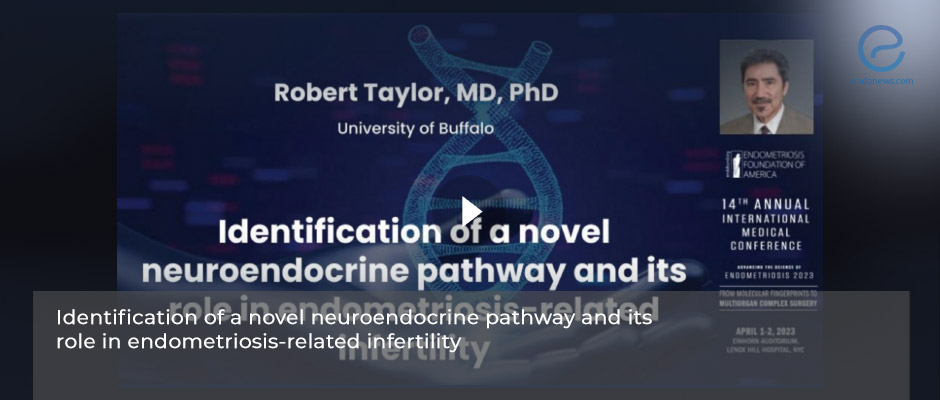Neuroendocrine pathway in endometriosis-related infertility
May 16, 2023
Dr. Taylor unravels the link between endometriosis, infertility, and neuroendocrine factors
Key Points
Highlights
- Dr. Taylor presented on the neuroendocrine pathway in endometriosis-related infertility and how implantation and pregnancy establishment might be disrupted in endometriosis at the Annual International Medical Conference of the Endometriosis Foundation of America held in New York on April 1-2, 2023.
- Investigating the role of neurosecretory neurons and their impact on endometrial biology provides valuable insights into the complex mechanisms underlying endometriosis-associated pain and infertility, potentially leading to new treatment approaches.
- The identification of dopamine receptor D2 (DRD2) expression in endometrial cells and its hormone-regulated nature highlights the potential for dopaminergic drugs to enhance endometrial stromal cell differentiation and potentially improve fertility outcomes in women with endometriosis.
Importance:
- Understanding the neuroendocrine pathway and molecular differences in endometriosis-related infertility is crucial for developing targeted therapies and interventions to improve fertility outcomes in women with endometriosis.
Outlines:
- Dr. Taylor presented on the neuroendocrine pathway in endometriosis-related infertility.
- They evaluated the endometrium for its neuroendocrine activity by staining it with tyrosine hydroxylase to detect catecholaminergic nerves.
- They used Cabergoline, a DRD2 agonist, to investigate its effects on endometrial stromal cell differentiation.
- Catecholaminergic nerves producing dopamine are present in the endometrium.
- DRD2 is expressed in endometrial cells and can be regulated by hormones.
- Cabergoline promotes endometrial stromal cell differentiation, while the DRD2 antagonist Risperidone blocks it.
- Dopaminergic drugs acting via DRD2 may have fertility-enhancing effects and should be tested in animal models.
Lay Summary
Dr. Robert Taylor from Jacobs School of Medicine, University at Buffalo presented on the newly defined neuroendocrine pathway and its role in endometriosis-related infertility and how implantation and pregnancy establishment might be disrupted in endometriosis at the Annual International Medical Conference of the Endometriosis Foundation of America held in New York on April 1-2, 2023.
It was shown that within the eutopic endometrial cavity, the decidualized stromal phenotype in women with endometriosis is quite different at a molecular level than the normal population. He stated that markers of progesterone resistance, in other words, healthy stromal decidualization, seem to be absent in women with endometriosis. Different gene expression patterns corroborated implantation defects which might be linked to infertility related to endometriosis.
There has been a focus on neurogenesis in the endometrium. It is now known that neurosecretory neurons secrete a variety of bioactive amines into the endometrium such as NCAM-L1 and NF-L which can be shown by fluorescent immunohistochemistry. It is believed that these nerve fibers are attracted into the endometrium through the secretion of neurotrophic factors such as Brain-Derived Neurotrophic factor (BDNF). The question Dr. Taylor and colleagues tried to uncover was whether these nerves were neuroendocrine active (catecholamine secreting) and if so whether they have an effect on endometrial biology. To reveal this, they stained the endometrial tissue with tyrosine hydroxylase, an enzyme responsible for the production of dopamine. The dominant dopamine receptor expressed in the endometrium is Dopamine Receptor D2 (DRD2) which is upregulated during the luteal phase of the menstrual cycle correlating with ovarian steroid production. DRD2 is stained mostly cytoplasmically with some nuclear staining in the endometrial stroma.
They used Cabergoline which is a dopamine receptor agonist selective for DRD2. Endometrial stromal cells differentiated and manifested in vitro under hormonal treatment as well as with Cabergoline and underwent a mesenchymal-epithelial transition which showed that Cabergoline had some effects on the differentiation of these cells. It was also shown that endometrial stromal differentiation was accelerated in vitro by Cabergoline and blocked by Risperidone, the DRD2 antagonist.
He concluded that endometrium has an active and innervated tissue microenvironment and that the neurons may contribute to endometriosis-associated pain and in addition have neuroendocrine effects on endometrial receptivity and fertility. They have proven the presence of catecholaminergic nerves in eutopic endometrium which were positively stained with tyrosine hydroxylase indicating that these nerves were able to produce catecholamine and the receptors for these catecholamines in particular DRD2 is expressed in endometrial cells and can be regulated in a hormone dependent fashion. Finally, the dopaminergic drugs that act via DRD2 are potent stimuli for endometrial stromal cell differentiation and should be tested in animal models for their potential fertility-enhancing effects.
Research Source: Identification of a novel neuroendocrine pathway and its role in endometriosis-related infertility - Robert Taylor, MD, PhD
endometriosis neuroendocrine infertility dopamine cabergoline

